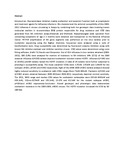| dc.contributor.author | Wadegu, M | |
| dc.contributor.author | Bulimo, W | |
| dc.contributor.author | Osanjo, G | |
| dc.contributor.author | Wamunyokoli, F | |
| dc.contributor.author | Coldren, R | |
| dc.date.accessioned | 2015-02-17T13:27:05Z | |
| dc.date.available | 2015-02-17T13:27:05Z | |
| dc.date.issued | 2014 | |
| dc.identifier.citation | Wadegu M, Bulimo W, Osanjo G, Wamunyokoli F, Coldren R. Neuraminidase Inhibitor Susceptibility of Influenza A isolates obtained in Kenya, 2008-2011.. Hilton Hotel; Nairobi, Kenya; 2014. | en_US |
| dc.identifier.uri | http://hdl.handle.net/11295/80384 | |
| dc.description.abstract | Introduction: Neuraminidase inhibitors mainly oseltamivir and zanamivir function both as prophylactic and treatment agents for influenza infections. We characterized the antiviral susceptibility of the 2008-2011 influenza A viruses circulating in Kenya by combining both the genotypic data involving known molecular markers in neuraminidase (NA) protein responsible for drug resistance and IC50 data generated from NA inhibition assays.Materials and Methods: Nasopharyngeal swab specimen from consenting outpatients of age ≥ 2 months were obtained and transported to the National Influenza Center. RT-PCR amplification of NA gene segments was performed on the virus isolates prior to nucleotide sequencing using the BigDye chemistry. Sequences were analyzed using a suite of bioinformatics tools. Drug susceptibility was determined by fluorescent enzyme inhibition assay with known NA inhibitor-resistant and inhibitor-sensitive viruses. IC50 values were determined using curve fitting software, Grafit 7.0.Results and Discussion: Out of 836 influenza A virus isolates obtained (2008-2011), 108 (13%) were analyzed for markers of resistance to NA inhibitors. 64% (7/11) of the 2008 seasonal influenza A/H1N1 isolates depicted oseltamivir resistant marker H275Y. Influenza A/H3N2 and A/ (H1N1) pdm09 isolates lacked the H275Y mutation. A total of 28 isolates were further subjected to phenotypic susceptibility assay. The mean zanamivir IC50s were 1.75nM, 2.53nM and 1.84nM for the subtypes sH1N1, pH1N1 and H3N2 respectively. Eight of the 2008-2009 sH1N1 isolates analyzed showed highly reduced sensitivity to oseltamivir with IC50s ranges from 73nM-984nM. Pandemic A/H1N1 and A/H3N2 strains obtained between 2009-2011and 2008-2011 respectively depicted normal sensitivity. The 2011, WHO range and median IC50 values for oseltamivir carboxylate were 257nM-3455nM and 458.2nM; 132nm-2179nM and 191.3nM; 23-378 and 42.3nM for the mutant subtypes sH1N1, pH1N1and sH3N2 respectively.Conclusion: Overall genotypic and phenotypic data demonstrate oseltamivir resistance in the 2008-2009, sH1N1 viruses. The H275Y mutation increased the IC50 by 50-100 fold. | en_US |
| dc.language.iso | en | en_US |
| dc.publisher | University of Nairobi | en_US |
| dc.title | Neuraminidase inhibitor susceptibility of influenza a isolates obtained in Kenya, 2008-2011. | en_US |
| dc.type | Presentation | en_US |
| dc.type.material | en | en_US |

